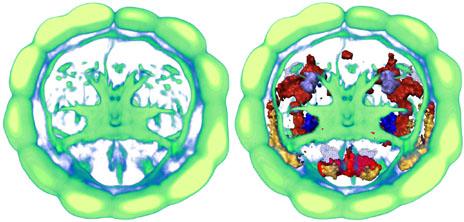Worm gene maps give clue to higher brain evolution
- Published

(L) Map averaged from 36 Platynereis brains. (R) Gene expression mapped on to the virtual brain
Researchers at the European Molecular Biology Laboratory have mapped the nervous system of worms to try and understand how the human cerebral cortex evolved.
This part of the brain is the one that makes people capable of complex thought, language, music, planning and many other important skills.
Raju Tomer and colleagues at EMBL mapped where genes are expressed in the nervous system of a marine ragworm, Platynereis.
They found that the worms had structures with molecular fingerprints closely related to the pallium - another name for the cortex in vertebrates. Before this, scientists thought that a pallium could only be found in much more evolved creatures.
This finding means that worms may have been able to learn information about food sources on the ocean floor - and also that our higher thought processes might have a very ancient evolutionary origin.